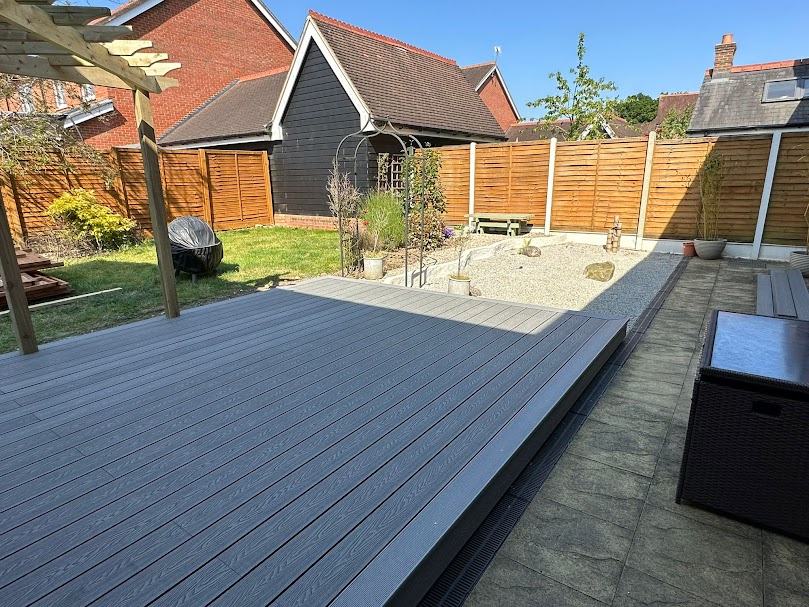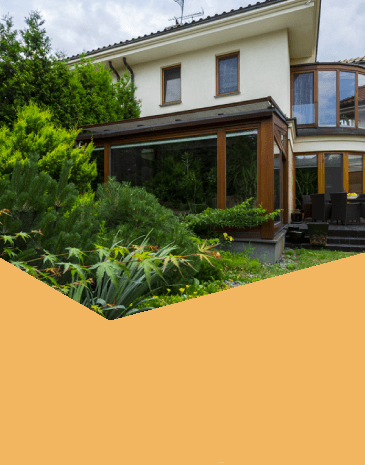

Imagine your garden, a canvas awaiting the stroke of your personal design aesthetic.
Composite decking is an embodiment of such creativity. It merges the allure of natural timber with the resilience of engineered materials, creating a durable, low-maintenance sanctuary. As homeowners, it is paramount to understand this innovative blend of form and function, which transforms outdoor spaces into enduring extensions of our homes, imbued with beauty and practicality.
Composite decking represents the synergy between aesthetics and durability that defines contemporary outdoor living spaces. It is comprised of a fusion between recycled plastics and wood fibres, moulded into planks that simulate the texture and appearance of traditional timber without its susceptibility to decay.
In its composition, this advanced decking solution incorporates a blend of high-density polyethylene (HDPE) or low-density polyethylene (LDPE), combined with wood particles, often by-products from the lumber industry, to deliver a product that stands resilient against the elements. The incorporation of recycled materials makes composite decking a conscientious choice for the environmentally aware homeowner.
The term “composite” is indicative of its multi-material makeup, ensuring a finished product that offers reduced maintenance, longevity, and resistance to rotting, warping, and splintering that is characteristic of wood decking systems.
Composite decking, artfully engineered for longevity, seamlessly synthesises recycled plastics with wood fibres. This robust composition resists decay far better than traditional timber, redefining durability with a sustainable touch.
Carefully selected materials define composite decking’s essence—a deft combination of high or low-density polyethylene and wood particles. These ingredients, often sourced as by-products, coalesce into planks of unmatched resilience and environmental respectability.
Composite decking, a testament to sustainable innovation, embraces recycled elements to enhance outdoor aesthetics and functionality.
The allure of composite decking lies in its complex makeup: it triumphantly marries aesthetics with functionality. Each board embodies strength (borne from its plastic constituents) and the organic allure (through wood derivatives), delivering a surface synonymous with modern outdoor elegance and ecological sensitivity.
Composite decking offers unmatched durability.
With a life span extending decades beyond wood, composite decking is a superlative choice for the discerning homeowner. Unlike natural timber, composite does not require staining, painting, or sealing and maintains its splendour with minimal effort. Moreover, it neither warps nor splinters over time, ensuring a consistent appeal and safety not guaranteed by its traditional counterpart.
Ease of maintenance elevates composite above conventional wood.
The need for only occasional cleaning stands out—a simple soap and water solution suffices to restore its original lustre. This starkly contrasts with wood’s demands for frequent treatments to fend off rot and pest invasion—an efficacy further compounded by the material’s resistance to common decking threats such as moisture and sun damage.
Composite materials epitomise eco-friendly solutions.
Their integration of recycled plastics and wood fibres aligns with environmentally conscious practices. As the sustainability dialogue advances in 2023, embracing materials that embody a reduced carbon footprint becomes an imperative. Composite decking offers an opportunity to contribute positively to this dialogue, presenting a sustainable alternative that reduces demand on forestry resources and champions recycling innovation.
Prior to the laying of composite decking, a sturdy foundation is paramount, one that will support the composite boards unwaveringly across their lifespan. A meticulously crafted substructure, built with pressure-treated timber, introduces a level of redundancy essential for ensuring stability and eliminating potential issues such as sagging or warping over time.
The spacing of support joists underneath the decking must adhere to a “golden measure,” typically established by the manufacturer’s guidelines. This spacing not only influences the overall stability and force distribution of the deck but also plays a crucial role in ensuring proper ventilation. Ample space between the composite boards is necessary for air circulation, reducing the risk of moisture accumulation that could otherwise provoke degradation of both the decking and substructure.
Initial planning for composite decking should precisely define the desired area, ensuring suitability for the intended purposes and spatial harmony with the existing garden or outdoor space.
Accurate measurements are the cornerstone of a successful decking project, encapsulating length, width, and depth dimensions to inform material estimates and to stake out the precise location for installation.
To circumvent future complications, consider the orientation of decking boards in relation to the property to optimise for both aesthetic appeal and practical utility, such as natural foot traffic patterns.
Robust planning includes accounting for additional components beyond the boards themselves; this includes joists, fasteners, and any unique trim or finishing elements that may affect dimensions and spacing.
Revisit your measurements and plans meticulously before commencement of construction to ensure a flawless installation and the aesthetics of a professionally finished deck.
The correct tools and techniques are indispensable for the successful installation of composite decking.
Quality decking requires precision – the aforementioned tools facilitate this precision.
Composite decking often necessitates specific installation techniques to accommodate material characteristics.
When considering composite decking, one must appreciate its resistance to the typical vulnerabilities of natural timber. Unlike wood, composite decking is impervious to termites, warping, and decay, substantially reducing the exigency for continual upkeep. It is engineered for longevity, boasting a remarkable ability to withstand adverse weather conditions without succumbing to the detrimental effects of moisture or sunlight. This resilience translates to a sustained aesthetic and structural integrity over an extended period. The ease of maintenance—often requiring little more than occasional cleaning with soap and water—ensures that your investment not only enhances your property’s value but also endures as a lasting outdoor feature.
Regular maintenance is essential.
Gentle cleaning methods are highly recommended for composite decking to preserve its integrity over time. A regular schedule of sweeping and washing with mild soapy water is crucial to prevent the build-up of dirt and debris, which can lead to unsightly spots and potentially damaging mould growth. Harsh chemicals or high-pressure washers should only be used with caution to avoid damaging the decking’s surface.
Avoid abrasive tools and harsh chemicals.
For tougher stains, use specialised composite deck cleaners. If general cleaning is not sufficient to remove stubborn stains or mild spots of mould, turn to solutions formulated specifically for composite decking. These are designed to tackle tougher jobs without compromising the material’s finish or colour.
Rinse thoroughly after cleaning to prevent residue. Ensuring all soapy water and cleaning products are completely rinsed away will prevent any harmful residue from settling into the composite material. Leftover cleaning solutions can dry and lead to discolouration or a reduction in the decking’s anti-slip properties, which are essential for safety.
Composite decking is engineered for durability, boasting a life span that trounces traditional timber. However, its longevity is contingent on appropriate maintenance practices, just like any other outdoor material.
Climatic conditions significantly influence decking performance. Extreme weather, be it throbbing heat or freezing temperatures, can impact its lifespan.
Ensuring composite decking is correctly installed with adequate support and spacing allows for expansion and contraction. Without this consideration, decking boards could warp or shift, leading to premature damage.
Investing in higher-quality composite materials with robust warranties can yield long-term benefits. Inferior products might not withstand the test of time, often showing signs of wear or fading more rapidly. Choosing the right product, therefore, becomes a strategic decision balancing cost against functionality and longevity.
Composite decking merges contemporary elegance with enduring practicality, offering an array of colours and finishes that mimic natural wood’s warmth and texture. Design choices span from classic earth tones to bold, variegated patterns, enabling a customised touch that harmonises with the architectural style of your home.
The versatility of composite materials ensures your outdoor space can mirror your personal aesthetic. Whether seeking the understated sophistication of monochromatic hues or the rich, nuanced appearance of multi-tonal boards, composite decking can elevate the visual appeal of your property’s exterior.
Composite decking offers exceptional aesthetic versatility.
Given their synthetic composition, composite decking planks can be crafted in a vast spectrum of colour options, ranging from traditional earthy browns to contemporary greys. Advances in manufacturing technology have emboldened producers, granting them the ability to replicate the nuanced hues of various wood species. Additionally, spectrum gradients and streaking are artfully incorporated to create planks that convincingly mimic natural wood.
A plenitude of finish options suits varied preferences.
Styles range from smooth, matte textures to deeply embossed, wood-like grains. Maintenance considerations guide some choices – smooth surfaces tend to be easier to clean – while visual preferences inform others. High-definition grain patterns, for instance, offer a strikingly realistic wood appearance.
Advanced colour retention technologies ensure long-lasting aesthetics.
Thanks to innovative protective coatings and UV stabilizers, today’s composite decking products maintain their vibrant colour and pristine finish for years. These advancements have redefined expectations for durability and beauty in outdoor decking, consolidating composite’s position as a prime choice for discerning property owners.
The art of integrating composite decking within your landscape requires attentive deliberation. It’s imperative to align the material’s aesthetic properties with the natural surroundings and the architectural style of your property.
The choice of finish and texture can profoundly influence the visual synergy between deck and domicile.
Achieving a seamless blend with the landscape thus enhances not only the aesthetics but also maximises the enjoyment of your outdoor haven.